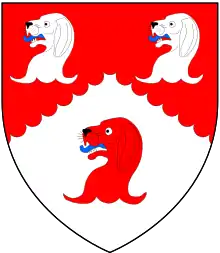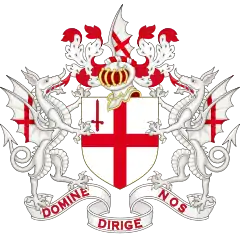Charles Duncombe (English banker)
Sir Charles Duncombe (1648 – 9 April 1711)[1] of Teddington, Middlesex and Barford, Wiltshire, was an English banker and Tory politician who sat in the English and British House of Commons between 1685 and 1711. He served as Lord Mayor of London from 1708 to 1709. He made a fortune in banking and was said to be worth £400,000 later in life, and the richest commoner in England on his death.

Early life
Duncombe was baptized on 16 November 1648, the second son of Alexander Duncombe of Drayton Beauchamp, Buckinghamshire, and his wife Mary Pawley, daughter of Richard Pawley of Whitchurch, Buckinghamshire. He was apprenticed to the London goldsmith Edward Backwell in 1665 and became in 1672 a member of the Goldsmiths' Company. He was tipped off by Lord Shaftesbury to withdraw a large sum of money from the Treasury before the Government suspended payment, and when Backwell was ruined because of the suspension, Duncombe took over his premises in Lombard Street at the sign of the Grasshopper.[2]
Banker and official
In 1680, Duncombe was appointed Cashier of excise at an annual salary of £600 p.a, holding the post until 1697 and Commissioner for the Mint, holding the post until 1686. He was six clerk in Chancery from 1682 to 1683. On the basis of the public income from all these posts he helped found a new type of credit agency. He was also able to make additional money by rigging the market in Exchequer tallies.[2] He also served as alderman for Broad Street ward in the City of London from 1683 to 1686 (from which he was discharged by Royal Commission).[3] In 1684 he was appointed Commissioner for tin coinage 1684 until 1687, and Cashier of hearth-tax at a salary of £400 p.a. in return for a £50,000 loan to the King at five per cent interest, holding the post until November 1688.[2] When James II fled the country in 1688, Duncombe refused him a loan of £1,500 to aid his escape.
Political career
At the 1685 English general election, Duncombe was returned unopposed as Member of Parliament for Hedon as a Court supporter. He was very active in Parliament and served on 14 committees, including the committee of elections and privileges.[2] At the 1690 English general election he transferred to Yarmouth (Isle of Wight) where he was again returned unopposed. At the 1695 English general election he transferred again to Downton, supporting the Tories.[4] During this period he opposed the establishment of the Bank of England. In 1694 he bought the 40,000 acre Helmsley estate, now Duncombe Park.
In 1698, Duncombe was arrested and imprisoned in the Tower of London, and subsequently expelled from the House of Commons, for "contriving and advising the making of false Indorsements of several Bills, made forth at the Receipt of Exchequer, commonly called Exchequer-Bills", in other words a tax fraud. He was expelled from the House of Commons on 1 February 1698. However, at his trial, he was acquitted through a mistake in the information. He was knighted on 20 October 1699.[2] He was Alderman for Bridge Within ward from 1700 until his death and was Sheriff of London in 1700.[3] At the first general election of 1701 he was defeated at Downton but was returned to parliament as MP for Ipswich. At the second general election of 1701 he was defeated when he stood for the City of London, and having not stood at either Ipswich or Downton, was excluded from Parliament until the 1702 English general election when he was returned for Hedon and Downton, choosing to sit for the latter. He was appointed to a committee to investigate the prices of coal in London and in February 1703 he handled his constituents' petition for an extra market day at Downton. He avoided voting for the Tack in 1704. At the 1705 English general election he was returned again for Downton and voted against the Court candidate for Speaker on 25 October 1705. He was fairly inactive in Parliament but in the City of London he came under attack from Whigs who removed him as a militia colonel, and his mayoral ambitions were overlooked by the court of aldermen.[4]
At the 1708 British general election, Duncombe was returned again unopposed for Downton and in September 1708 became Lord Mayor of London to the indignation of the Whigs.[4] He was to have had a publicly performed pageant for his, but it was stopped by the death of Prince George of Denmark (Queen Anne's husband), the day before.[5] In May 1709 he endorsed the candidacy of Dr Henry Sacheverell for the chaplaincy of St Saviour's, Southwark and later showed Tory partisanship by reportedly giving only £50 for the relief of the Palatine refugees, and only for the sake of his office. Though generally known for support of charitable causes and praised by the poor debtors of the Wood Street compter for his help while Mayor, the Palatines were a Whig cause. He opposed the impeachment of Sacheverell in 1710, later entertaining him at his home in Teddington. He was returned as MP for Downton at the 1710 British general election, and was later cited as one of the ‘worthy patriots’ who in the first session of the 1710 Parliament helped to detect the mismanagements of the previous administration'. However Harley was disappointed that he was unforthcoming in providing any financial support for the administration.[2]
Death and legacy
Duncombe died unmarried at Teddington on 9 April 1711, and was described as ‘the richest commoner of England’. His brother, Anthony Duncombe, was also MP for Hedon, died before him. His nephew and heir, also called Anthony, was later ennobled as Lord Feversham. His sister Ursula Duncombe inherited half of Duncombe's fortune and was the ancestor of the present-day Barons Feversham.
References
- http://www.twickenham-museum.org.uk/detail.php?aid=63&ctid=1&cid=17
- "DUNCOMBE, Charles (1648-1711), of Lombard Street, London and Teddington, Mdx". History of Parliament Online (1660-1690). Retrieved 16 January 2019.
- Alfred P Beaven. "'Chronological list of aldermen: 1651-1700', in The Aldermen of the City of London Temp. Henry III - 1912 (London, 1908), pp. 75-119". British History Online. Retrieved 10 December 2018.
- "DUNCOMBE, Charles (1648-1711), of Teddington, Mdx. Barford, Wilts". History of Parliament Online (1690-1715). Retrieved 16 January 2019.
- Walter Thornbury. "'The Lord Mayors of London', in Old and New London: Volume 1 (London, 1878), pp. 396-416". British History Online. Retrieved 16 January 2019.
- 'Dakins - Dyer', The Rulers of London 1660-1689: A biographical record of the Aldermen and Common Councilmen of the City of London (1966)
- House of Commons Journal, 18 March 1698
- Dictionary of National Biography
- Craig, John (1953). The Mint: A History of the London Mint from A.D. 287 to 1948. Cambridge, England: Cambridge University Press. p. 177. ASIN B0000CIHG7.
| Parliament of England | ||
|---|---|---|
| Preceded by Henry Guy William Boynton |
Member of Parliament for Hedon 1685–1687 With: Henry Guy |
Succeeded by Henry Guy Matthew Appleyard (younger) |
| Preceded by Sir Robert Holmes Hon. Fitton Gerard |
Member of Parliament for Yarmouth 1690–1695 With: Sir John Trevor 1690–95 Henry Holmes 1695 |
Succeeded by Henry Holmes Anthony Morgan |
| Preceded by Sir Charles Raleigh Maurice Bocland |
Member of Parliament for Downton 1695–1698 With: Sir Charles Raleigh |
Succeeded by Sir Charles Raleigh Maurice Bocland |
| Preceded by Sir James Ashe Carew Raleigh |
Member of Parliament for Downton 1702–1707 With: Sir James Ashe 1702–05 John Eyre 1705–07 |
Succeeded by Parliament of Great Britain |
| Parliament of Great Britain | ||
| Preceded by Parliament of England |
Member of Parliament for Downton 1707–1711 With: John Eyre 1707–11 |
Succeeded by John Eyre Thomas Duncombe |
| Civic offices | ||
| Preceded by Sir William Withers |
 1708–1709 |
Succeeded by Sir Samuel Garrard, Bt |